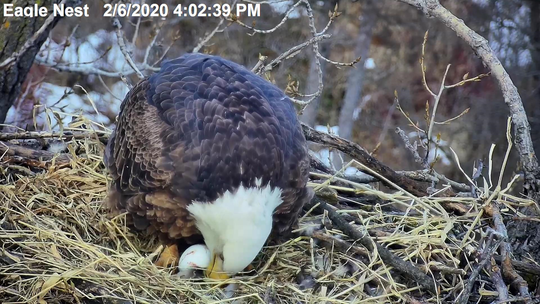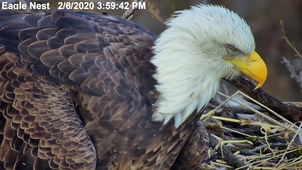|
February 7, 2020

For the first time in two years, our birds have laid an egg in the EagleCam nest! The first DNR EagleCam egg arrived at approximately 3:47 p.m. on Thursday, Feb. 6. Eagles typically lay between one and three eggs, and they do so asynchronously (the eggs are laid between one and four days apart – not all at once). Because eggs are laid over several days, they also hatch several days apart in the order in which they were laid. Sometimes, though, birds (including eagles) will delay incubation of the first egg or two, so that all the eggs hatch on the same day, or close to the same day. Incubation lasts about 35 days -- which means we might have chicks around mid-March. So stay tuned!
In case you missed it, you can watch the video of the first egg being laid.

Several watchers noticed that after she laid the egg, our adult female eagle appeared exhausted, resting with her eyes closed. No cause for alarm -- this is to be expected. Laying an egg is hard work!
|
As eagle activity increases we will be sending out regular email updates every other Friday, with extra updates when something especially exciting happens (like the first egg). Keep an eye on your inbox. People can sign up for updates about the EagleCam and many other interesting topics on the DNR website.
Also, be sure to check out our Nongame Wildlife Program Facebook page (You DO NOT need to have a Facebook account to view posts and photos). We also post EagleCam updates on the Minnesota Department of Natural Resources page and via Twitter, so be sure to follow @mndnr.
|